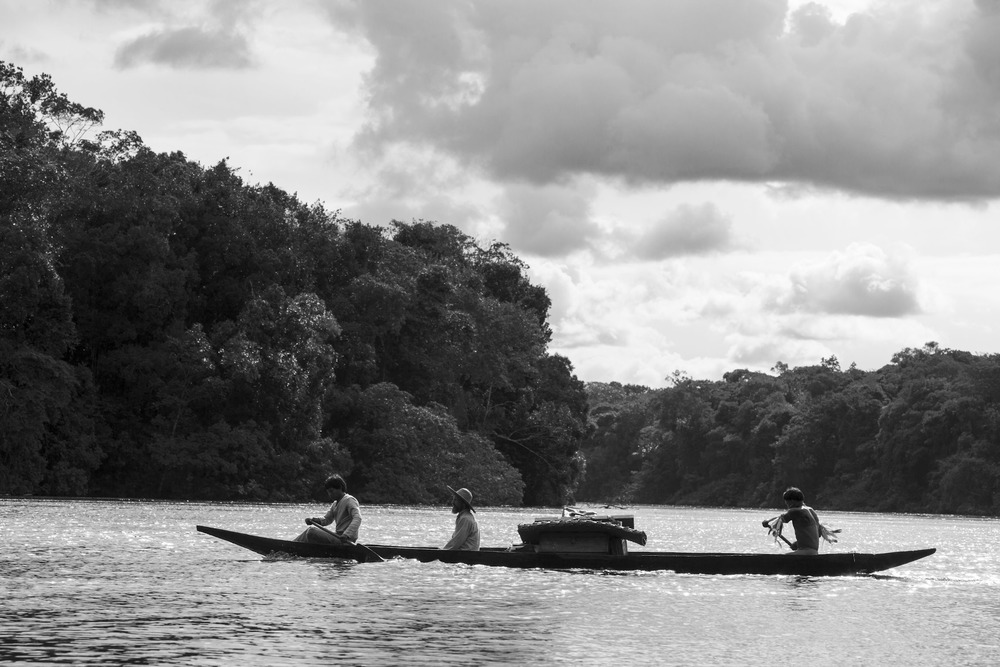Embrace of the Serpent [2015] is director Ciro Guerra’s third and latest film. This is the story of an Amazonian shaman named Karamakate. He is the last of his tribe. Wayfaring through the Amazon, his path crosses with two scientists—one German and one American—when he is asked to help these men who, though seemingly differently motivated, have the same mission: to locate the rare and sacred Yakruna plant that lore tells of possessing incomparable healing abilities.
Thoughtful Stories… In this film, if the main character, Karamakate, is our anchor—much like that of an axis on a Cartesian plane—then our two scientists’ paths are mirror image asymptotes that run parallel to this axis until they irrevocably do not. Guerra has said that he wanted to re-imagine an age-old tale, yet keep it relatable and he is successful in this: his is a tale that intertwines past and present where the former seems to inform the latter; and, if anything is relatable it’s this notion of the past informing the present/future. In using a nonlinear story structure, Guerra actively invites his audience to compare the two scientists’ similar but distinct journeys and interactions with Karamakate, almost hinting that one scientist is the spiritual successor of the other. In looking at the similarities and differences of these two journeys, Guerra also interrogates the effect that the Amazon can have on man. There’s a transformative power to the Amazon—and arguably nature at large; enter and you’ll either find transcendence or become engulfed and we, the viewers, get to witness this unfold. This act of comparing and contrasting is not only limited to the two scientists: Guerra’s interrogation of the effect that the Amazon has on man is contrasted with an examination of the effect that man has on the Amazon and the result is a balanced and contemplative story.
Thoughtful Images… Embrace of the Serpent is a memorable film for many reasons and one of those reasons is its cinematography, which is arresting in its beauty and exquisite in its artistry. Guerro and DP David Gallego capture the Amazon forest in a way that is at once exactly how one imagines the forest to be and exactly nothing like it at all. By filming in black and white, the fundamental elements of the forest are captured but transmuted. In thinking about the Amazon, the basest association is a thicket of green: a thriving, bustling biomass; but, Guerra’s film is shot in black and white. In doing so, he presents before us an Amazon that’s actively manipulated and represented. Images are finite, but the forest is infinite. Perhaps filming in black and white is the means by which Guerra reconciles with the problem of trying to capture the intangible, i.e. the essence of the forest. Theodor von Martius himself—one of the scientists whose journals inspired this story—has called the Amazon enchanting, stating that it would be “impossible to describe in a language that would make others understand its beauty and splendor”. In addressing the limitations of the medium, Guerro sidesteps the impossible task of translating the Amazon’s majesty into motion picture while simultaneously producing a film that looks stunning beyond belief.
Thoughtful Questions… This film lingers in the mind for more reasons than its story and cinematography alone. Embrace of the Serpent explores many themes and issues with nuance and refuses to settle for easy answers or make banal criticisms. Films that touch upon ‘Big Issues’ and ask ‘Big Questions’ can fairly easily become agenda driven and evangelical in its point of view and few things in life are more overwrought and unsavory than this. And Embrace of the Serpent certainly touches upon no shortage of Big Issues & Questions, yet Guerra’s film preaches sparingly. Instead, Guerra constructs situations and tableaus that asked its viewers to connect the dots and find answers for themselves. Watching this film is a rewarding mental exercise and Guerra’s film asks us to ponder about all manners of questions: Can a scientist interact with a culture without leaving an indelible mark? When Colonialist agendas meet with indigenous traditions and rituals, what are the corollaries? What role and significance does the religious imagery play? Is a serpent’s embrace also a stranglehold and what does that mean in relation to the overarching metaphor? These are but a few questions that come to mind. If nothing else, this film has the potential to instigate some interesting conversations and to have an interesting conversation is partly why I’m writing this and why you’re reading it, no?
A memorable and cerebral experience.

